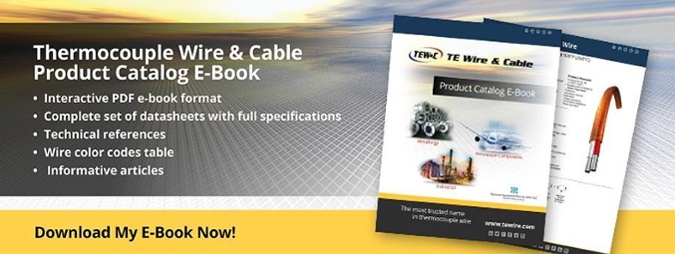As you approach higher and higher temperatures for your applications, it’s hard not to think of fiberglass insulated products. S-Glass and E-Glass, we refer to as Q-Glass and G-Glass respectively. These braided products, come in many different variations depending on the use, not to mention there are also different saturants, grades of thermocouple, shields, and armors that can be applied over/to your wire or cable.
Insulation: Why use fiberglass?
In making your thermocouple purchasing decisions, you should ask yourself
two questions:
- What’s the highest temperature my application will require?
- What type of environment will my thermocouple experience?
For long standing use of temperatures between 650 F and 1600 F, use a fiberglass product when considering insulation. The kind of insulation you would use goes in accordance with the temperature range your application will experience. It’s actually that simple. Do keep in mind, however, we are purely talking insulation here.
What kinds of fiberglass products do we offer?
One of our more popular fiberglass products right now would be our Q-Glass product. It can insulate a temperature range up to 1600 F, which provides a higher maximum temperature than our G-Glass or PFA products. Many of the applications in the industry are built within the Q-Glass range. Fiberglass tends to be smaller and lighter than other materials, which makes using this insulation better fitting in your application. If you know your application requires temperatures below 1300 F, one of our G-Glass products would be optimal for your application. The type of insulation merely depends on the temperature of the application. Additionally, a fiberglass braided insulation over each bare wire conductor is coated with a colored or clear binder. A B-fiber braided jacket with the pair can provide a low-cost protective layer, which offers significant abrasion resistance properties but lowers the temperature range.
Making it your own
One downside to fiberglass is that it is porous on its own, so it’s not very good in wet environments. To combat such conditions, the use of mica or Teflon tape could improve protection against moisture. Just like with any application, the wire may need to be fitted to your needs. Will the wire or cable endure rough usage or treatment? You might want to consider adding a metal braid or wrap in addition to the insulation and/or the jacket. Or, we could make a twisted product with a metal braid or wrap and no jacket. Will your wire be affected by other electrical equipment? The appropriate shielding could be added to prevent such disturbances [click here for a copy of our product catalog].
There are many other facets to building your own thermocouple which can be much more complex. I hope to uncover some of these other facets in future blogs, all in an effort to help you choose the proper cable for your application.
You might also be interested in the following related products:
 Accuclave Tracking
Accuclave Tracking
